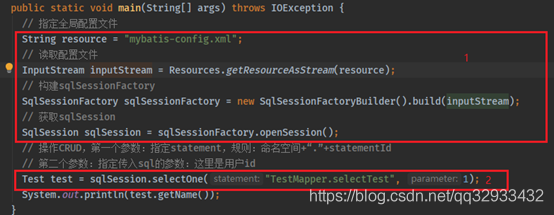详解Mybatis是怎样解析配置文件的
诺浅 人气:1缘起
经过前面三章的入门,我们大概了解了Mybatis的主线逻辑是什么样子的,在本章中,我们将正式进入Mybatis的源码海洋。
Mybatis是如何解析xml的
构建Configuration

我们调用new SqlSessionFactoryBuilder().build()方法的最终目的就是构建 Configuration对象,那么Configuration何许人也?Configuration对象是一个配置管家, Configuration对象之中维护着所有的配置信息。
Configuration的代码片段如下
public class Configuration {
//环境
protected Environment environment;
protected boolean safeRowBoundsEnabled;
protected boolean safeResultHandlerEnabled = true;
protected boolean mapUnderscoreToCamelCase;
protected boolean aggressiveLazyLoading;
protected boolean multipleResultSetsEnabled = true;
protected boolean useGeneratedKeys;
protected boolean useColumnLabel = true;
protected boolean cacheEnabled = true;
protected boolean callSettersOnNulls;
protected boolean useActualParamName = true;
protected boolean returnInstanceForEmptyRow;
//日志信息的前缀
protected String logPrefix;
//日志接口
protected Class<? extends Log> logImpl;
//文件系统接口
protected Class<? extends VFS> vfsImpl;
//本地Session范围
protected LocalCacheScope localCacheScope = LocalCacheScope.SESSION;
//数据库类型
protected JdbcType jdbcTypeForNull = JdbcType.OTHER;
//延迟加载的方法
protected Set<String> lazyLoadTriggerMethods = new HashSet<String>(
Arrays.asList(new String[] { "equals", "clone", "hashCode", "toString" }));
//默认执行语句超时
protected Integer defaultStatementTimeout;
//默认的执行器
protected ExecutorType defaultExecutorType = ExecutorType.SIMPLE;
//数据库ID
protected String databaseId;
//mapper注册表
protected final MapperRegistry mapperRegistry = new MapperRegistry(this);
//拦截器链
protected final InterceptorChain interceptorChain = new InterceptorChain();
//类型处理器
protected final TypeHandlerRegistry typeHandlerRegistry = new TypeHandlerRegistry();
//类型别名
protected final TypeAliasRegistry typeAliasRegistry = new TypeAliasRegistry();
//语言驱动
protected final LanguageDriverRegistry languageRegistry = new LanguageDriverRegistry();
//mapper_id 和 mapper文件的映射
protected final Map<String, MappedStatement> mappedStatements = new StrictMap<MappedStatement>(
"Mapped Statements collection");
//mapper_id和缓存的映射
protected final Map<String, Cache> caches = new StrictMap<Cache>("Caches collection");
//mapper_id和返回值的映射
protected final Map<String, ResultMap> resultMaps = new StrictMap<ResultMap>("Result Maps collection");
//mapper_id和参数的映射
protected final Map<String, ParameterMap> parameterMaps = new StrictMap<ParameterMap>("Parameter Maps collection");
//资源列表
protected final Set<String> loadedResources = new HashSet<String>();
未完.......
}
构建MappedStatement
在Configuration中,有个mappedStatements的属性,这是个MappedStatement对象Map的集合,其key是这个mapper的namespace+对应节点的id,而value是一个MappedStatement对象。
在构建Configuration的时候,会去解析我们的配置文件。
解析配置文件的关键代码如下
private void parseConfiguration(XNode root) {
try {
//issue #117 read properties first
propertiesElement(root.evalNode("properties"));
Properties settings = settingsAsProperties(root.evalNode("settings"));
loadCustomVfs(settings);
loadCustomLogImpl(settings);
typeAliasesElement(root.evalNode("typeAliases"));
pluginElement(root.evalNode("plugins"));
objectFactoryElement(root.evalNode("objectFactory"));
objectWrapperFactoryElement(root.evalNode("objectWrapperFactory"));
reflectorFactoryElement(root.evalNode("reflectorFactory"));
settingsElement(settings);
// read it after objectFactory and objectWrapperFactory issue #631
environmentsElement(root.evalNode("environments"));
databaseIdProviderElement(root.evalNode("databaseIdProvider"));
typeHandlerElement(root.evalNode("typeHandlers"));
mapperElement(root.evalNode("mappers"));
} catch (Exception e) {
throw new BuilderException("Error parsing SQL Mapper Configuration. Cause: " + e, e);
}
}
上诉代码段倒数第三行mapperElement(root.evalNode("mappers"));就是解析mappers处就是把我们的mapper文件封装成MappedStatement对象,然后保存到Configuration的mappedStatements属性中,其中key是这个mapper的namespace+对应节点的id,而value是一个MappedStatement对象。保存的地方关键代码如下
configuration.addMappedStatement(statement);
addMappedStatement()方法代码如下
protected final Map<String, MappedStatement> mappedStatements = new StrictMap<MappedStatement>(
"Mapped Statements collection");
public void addMappedStatement(MappedStatement ms) {
mappedStatements.put(ms.getId(), ms);
}
那么这个MappedStatement的又是何许人也?我们可以简单的把MapperStatement理解为对sql的一个封装,在MappedStatement中保存着一个SqlSource对象,其中就存有SQL的信息。相关代码如下
public final class MappedStatement {
private SqlSource sqlSource;
}
SqlSource 代码如下
public interface SqlSource {
BoundSql getBoundSql(Object parameterObject);
}
BoundSql代码如下
public class BoundSql {
private final String sql;
private final List<ParameterMapping> parameterMappings;
}
关于二级缓存
我们在Configuration中看到了一个caches属性
protected final Map<String, Cache> caches = new StrictMap<>("Caches collection");
这个东西的作用是什么呢?其实是关于Mybatis的二级缓存的。在解析配置文件的过程中,如果用到了二级缓存,便会把这个ID和对象也保存到configuration的caches中,相关代码如下
public void addCache(Cache cache) {
caches.put(cache.getId(), cache);
}
构建SqlSessionFactory
在Configuration对象构建完毕之后,就该依赖Configuration对象去构建SqlSessionFactory对象了,相关代码如下
public SqlSessionFactory build(Configuration config) {
return new DefaultSqlSessionFactory(config);
}
我们暂且把SqlSessionFactory称为SqlSession工厂吧,SqlSessionFactory中有两个方法,openSession()和getConfiguration()
SqlSessionFactory代码如下
public interface SqlSessionFactory {
SqlSession openSession();
//其余openSession重载方法略…
Configuration getConfiguration();
}
构建SqlSession
openSession()方法会返回一个SqlSession对象,SqlSession又是何许人也?SqlSession可以理解为程序与数据库打交道的一个工具,通过它,程序可以往数据库发送SQL执行。
SqlSession代码如下
public interface SqlSession extends Closeable {
<T> T selectOne(String statement);
<T> T selectOne(String statement, Object parameter);
<E> List<E> selectList(String statement);
<E> List<E> selectList(String statement, Object parameter);
//其余增删查改方法略…
}
总结
想必你已经明白了,Mybatis解析xml最主要的目的其实是构建Configuration对象,这个对象中可以说包含着Mybatis的所有配置信息。其中有一个mappedStatements属性,这是一个Map,其中key是这个mapper的namespace+对应节点的id,而value是一个MappedStatement对象,而MappedStatement中保存着一个SqlSource对象,这个对象中保存着我们要执行的SQL语句。
那么在下一章,我们将一起探究Mybatis是如何执行我们的SQL语句的。
加载全部内容